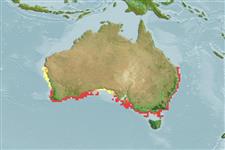>
Clupeiformes (Herrings) >
Clupeidae (Herrings, shads, sardines, menhadens)
Etymology: Hyperlophus: Greek, hyper = over + Greek, lophos = crest (Ref. 45335).
More on author: Castelnau.
Environment: milieu / climate zone / depth range / distribution range
Ecología
marino; salobre; anfidromo (Ref. 51243); rango de profundidad 10 - 13 m. Temperate; 25°S - 40°S, 112°E - 155°E (Ref. 188)
Distribución
Países | Áreas FAO | Ecosistemas | Ocurrencias, apariciones | Point map | Introducciones | Faunafri
Western Pacific: southern Australia, from Kalbarri, Western Australia to South Australia, New South Wales and Moreton Bay, Queensland.
Tamaño / Peso / Age
Maturity: Lm ? range ? - ? cm
Max length : 10.0 cm SL macho / no sexado; (Ref. 188)
Espinas dorsales (total): 0; Radios blandos dorsales (total): 12-18; Espinas anales 0; Radios blandos anales: 16 - 27. Body fairly elongate, belly keeled, with 19 to 24 - 10 to 13 scutes; 23 to 27 dorsal scutes with low keels from head to dorsal fin origin. Second supra-maxilla paddle-shaped, lower portion larger. Branchiostegal rays 4. Anal fin origin an eye diameter or more behind base of last dorsal fin ray. Scales more or less firm on body; a silvery band along flank.
Schools in large numbers in shallow sandy areas of bays and estuaries.
Life cycle and mating behavior
Madurez | Reproducción | Puesta | Huevos | Fecundidad | Larva
Whitehead, P.J.P., 1985. FAO Species Catalogue. Vol. 7. Clupeoid fishes of the world (suborder Clupeoidei). An annotated and illustrated catalogue of the herrings, sardines, pilchards, sprats, shads, anchovies and wolf-herrings. FAO Fish. Synop. 125(7/1):1-303. Rome: FAO. (Ref. 188)
IUCN Red List Status (Ref. 130435)
Threat to humans
Harmless
Human uses
Pesquerías: pesquerías de subsistencia; carnada: usually
Más información
ReferenciasAcuiculturaPerfil de acuiculturaRazasGenéticaElectrophoresesheritabilidadEnfermedadesProcesamientoNutrientsMass conversion
ColaboradoresImágenesStamps, Coins Misc.SonidosCiguateraVelocidadTipo de nataciónSuperficie branquialOtolitosCerebrosVisión
Herramientas
Special reports
Download XML
Fuentes de Internet
Estimates based on models
Preferred temperature (Ref.
123201): 15.3 - 23.6, mean 18 °C (based on 193 cells).
Phylogenetic diversity index (Ref.
82804): PD
50 = 0.7500 [Uniqueness, from 0.5 = low to 2.0 = high].
Bayesian length-weight: a=0.00389 (0.00180 - 0.00842), b=3.12 (2.94 - 3.30), in cm total length, based on all LWR estimates for this body shape (Ref.
93245).
Nivel trófico (Ref.
69278): 3.4 ±0.45 se; based on food items.
Resiliencia (Ref.
120179): Alto, población duplicada en un tiempo mínimo inferior a 15 meses (Preliminary K or Fecundity.).
Fishing Vulnerability (Ref.
59153): Low vulnerability (10 of 100).
Nutrients (Ref.
124155): Calcium = 168 [73, 338] mg/100g; Iron = 0.858 [0.448, 1.717] mg/100g; Protein = 18.7 [17.3, 20.0] %; Omega3 = 0.695 [0.331, 1.479] g/100g; Selenium = 6.96 [2.61, 17.54] μg/100g; VitaminA = 26.6 [8.4, 86.4] μg/100g; Zinc = 1.19 [0.78, 1.84] mg/100g (wet weight);
